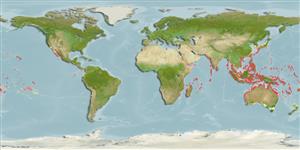Common names from other countries
Classification / Names / Names
Namen | Synonyme | Catalog of Fishes (gen., sp.) | ITIS | CoL | WoRMS
Environment: milieu / climate zone / depth range / distribution range
Ökologie
; tiefenbereich 0 - 15 m (Ref. 3204). Tropical
Indo-Pacific.
Length at first maturity / Size / Gewicht / Alter
Maturity: Lm ? range ? - ? cm Max length : 15.0 cm SHL Männchen/unbestimmt; (Ref. 349); common length : 10.0 cm SHL Männchen/unbestimmt; (Ref. 349)
Occasionally used as food. Must be carefully handled, as it can inflict painful bites with its poisonous, arrow-like teeth (Ref. 349). It is common in shallow waters with sandy substrates (Ref. 128042). Also found in subtidal areas where it feeds on gastropods (Ref. 3204).
Life cycle and mating behavior
Geschlechtsreife | Fortpflanzung | Ablaichen | Eier | Fecundity | Larven
This species is a non-broadcast spawner. Life cycle does not include trocophore stage. Also Ref. 833.
Poutiers, J.M. 1998. (Ref. 349)
IUCN Rote Liste Status (Ref. 130435)
CITES Status (Ref. 108899)
Not Evaluated
Not Evaluated
Bedrohung für Menschen
Traumatogenic
Nutzung durch Menschen
Fischereien: kommerzielles potential
| FishSource |
Tools
Mehr Information
Alter/Größe
Wachstum
Länge-Gewicht
Länge-Länge
Morphologie
Larven
Dichte
Internet Quellen
Estimates based on models
Preferred temperature
(Ref.
115969): 24.2 - 29.3, mean 28.3 (based on 3435 cells).
Verwundbarkeit
Low vulnerability (10 of 100).
Preiskategorie
Unknown.
